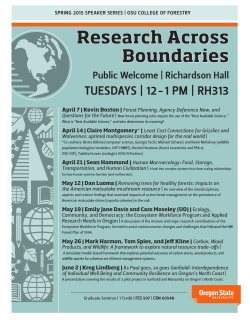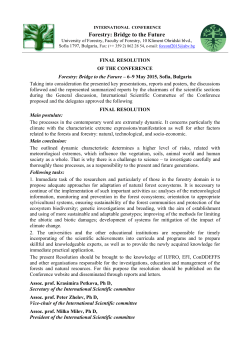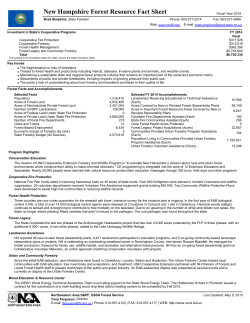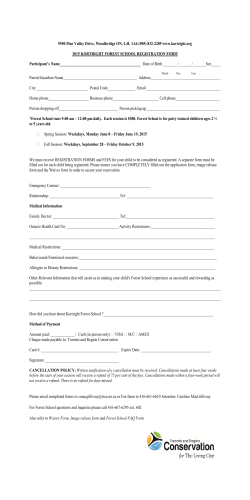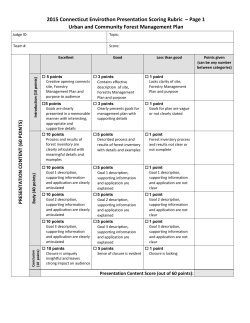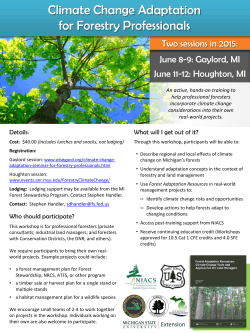
Minnesota Forest Resource Fact Sheet
Minnesota Forest Resource Fact Sheet Forrest Boe, State Forester Fiscal Year 2015 Phone: 651-259-5615 Web: www.dnr.state.mn.us/forestry/index.html Fax: 651-296-5954 E-mail: [email protected] Investment in State's Cooperative Programs FY 2014 Final $1,291,969 $632,800 $352,483 $40,000 $2,317,252 Cooperative Fire Protection Cooperative Forestry Forest Health Management Forest Legacy and Community Forestry Total This funding is for all entities within the state, not just the State Forester's office. Key Issues Improving forest health, productivity, and resiliency to help meet future forest resources demand: adapting to and mitigating the effects of climate change, invasive species, and maintaining water quality and quantity. Adapting forest management practices and systems to emerging markets for woody biomass and carbon credits. Minimizing the breakup of former industrial forests into small parcels that are sold to nonindustrial owners and converted to non-timber uses. Multi-agency and landowner cooperation to address forest management and wildfire suppression in light of higher costs and smaller budgets. Forest Facts and Accomplishments Selected Facts Population Acres of Forest Land Acres of Nonindustrial Private Forest Land Number of NIPF Landowners Acres of Federal Land Under State Fire Protection Acres of Private Land Under State Fire Protection Number of Rural Fire Departments Cities and Towns Forest Based Employment Economic Impact of Forestry (by rank) State Forestry Budget (All Sources) 5,303,925 17,370,394 6,467,000 202,000 0 45,037,000 748 854 39,867 4 39,000,000 Selected FY 2014 Accomplishments Landowners Receiving Educational or Technical Assistance (Each) Acres Covered by New or Revised Forest Stewardship Plans Acres in Important Forest Resource Areas Covered by New or Revised Stewardship Plans Volunteer Fire Departments Assisted (Each) State Fire Communities Assisted (Each) Coop Forest Health Acres Protected Forest Legacy Project Acquisitions (Acres) Communities Provided Urban Forestry Program Assistance (Each) Population Living in Communities Provided Urban Forestry Program Assistance (Each) Urban Forestry Volunteer Assistance (Hours) 3,803 41,653 31,468 250 216 52,778 0 216 3,635,188 51,260 Program Highlights: Cooperative Fire Protection The National Fire Plan aided in hazardous fuels reduction on 300 acres near high-risk communities. The state trained 225 local firefighters, while 225 volunteer fire departments received grants for equipment and training. State-distributed fire equipment to departments through the DOD Fire Fighter Property program acquisitions totaled $1,715,992. Forest Health Protection This is the fifteenth year of an outbreak of eastern larch beetle. It is estimated that tamarack mortality has occurred on more than 21.5% of the tamarack acreage in the state. Minnesota treated gypsy moth on almost 53,000 acres including almost 1,900 acres on the Superior National Forest, under the Slow the Spread Program, reducing spread rates by at least 60%. Cook and Lake counties were the first to fall under GM quarantine regulations in 2014. Bur oak blight (BOB) is considered to be a native but newly identified disease of bur oak. Wet spring weather patterns over the past decade have allowed annual development of the disease which has resulted in the decline and sometimes death of individual trees. Surveys have confirmed 74 of 87 counties to be positive for BOB. Forest Legacy The State’s order on conservation easement stewardship established two teams to provide support to Conservation Easement activities. The first is the Conservation Easement Stewardship Team to create consistent, Department-wide policy and guidance for the effective stewardship of protected properties. The second is the Enforcement Advisory Panel, comprised of staff of the Divisions that administer conservation easements. Landowner Assistance The state forestry agency is partnering with NRCS, US Forest Service, other state and local partners to develop a new service delivery modal for providing technical services to private forest landowners. The model engages landowners with varying levels of forest knowledge or interest at activity levels they find comfortable, with opportunities to increase activity over time. Partner buy-in allows better coordination and delivery of technical services and educational opportunities to better meet the needs of diverse forest landowners. Urban and Community Forestry In its fifth year, the Community Engagement and Preparedness Program serves over 30 communities statewide. It engages citizens in programs including tree surveys, the Citizen Pruner program, and gravel bed construction and maintenance as a low-cost way to buy and hold trees for later planting. In addition, 10 monthly forums were offered with topics ranging from pollinators to violent wind-loading events. 450 people attended these free opportunities to share information on a monthly basis. Wood Education & Resource Center UM's Natural Resources Research Institute is studying thermally-modified wood by tracking performance through demonstration decks in MN, WI and LA. State Wood Energy Team encourages use of woody biomass for energy. Grand Marais and FVB Energy of St. Paul completed an analysis of installing a district energy system to serve the community. The WERC Wood Energy Technical Assistance Team and partners are evaluating the use of wood energy in facilities in Ely. The Team has completed a preliminary evaluation and identified two projects involving multiple buildings. Northeastern Area S&PF, USDA Forest Service Last Updated: May 5, 2015 Tony Ferguson, Director E-mail: [email protected] | Phone: 610-557-4103 | FAX: 610-557-4177 | WEB: http://www.na.fs.fed.us
© Copyright 2026


